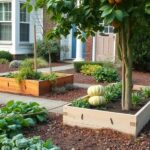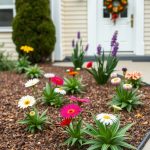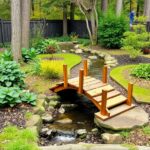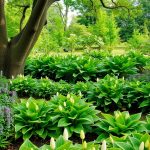Looking for ways to spruce up your outdoor space without the hassle of constant upkeep? You’re in the right place! Here are 27 low-maintenance landscape ideas that will help you create a beautiful yard with minimal effort. Let’s dive in and explore some easy and stylish options to make your landscape shine.
Native Plant Landscaping
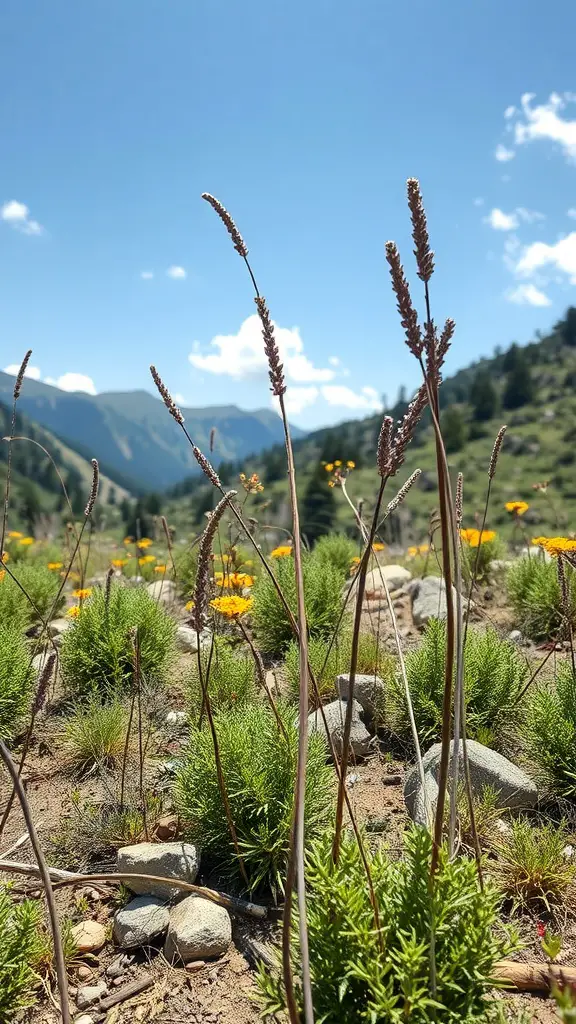
Incorporating native plants into your landscape is a wonderful way to create a low-maintenance garden that thrives in your local environment. The image above showcases a vibrant scene filled with native flora. You can see tall grass-like plants and cheerful yellow flowers set against a backdrop of mountains and blue skies.
Native plants are adapted to the climate, soil, and wildlife of your area. This means they require less water and fewer chemicals to maintain than non-native species. By choosing local plants, you also support local ecosystems, providing food and habitat for birds, insects, and other wildlife.
Take a closer look at the variety of textures and colors in the image. The lush greenery and colorful flowers not only add beauty but also reduce your need for fertilizers and pesticides. With native plant landscaping, you can enjoy a thriving garden that celebrates the natural beauty of your surroundings while keeping maintenance to a minimum.
Rock Garden Design
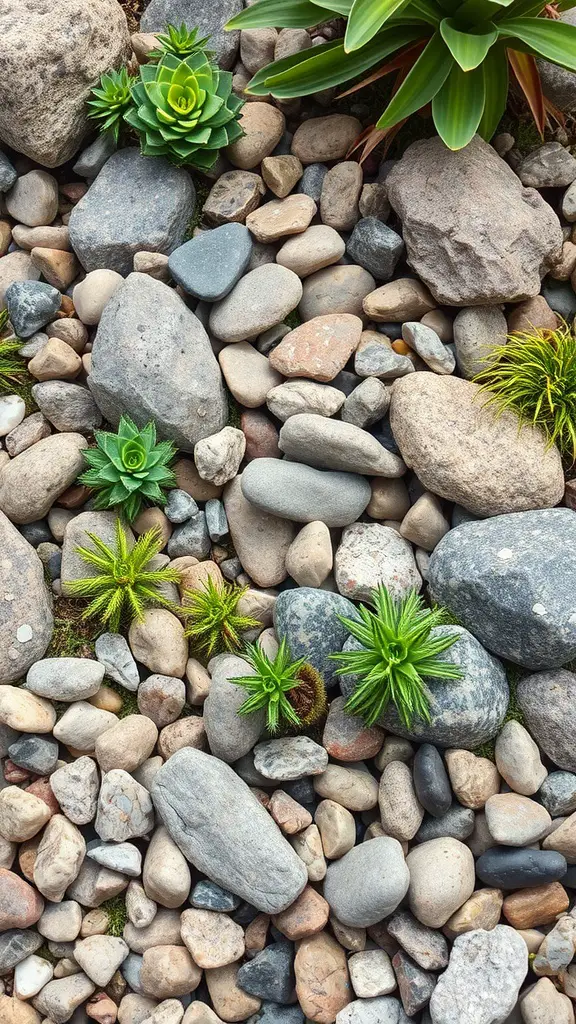
A rock garden is a beautiful way to showcase the natural beauty of stones and plants together. The image above highlights a lovely arrangement of various stones, complemented by lush green succulents. This combination not only adds visual interest but also requires minimal upkeep.
One of the key benefits of a rock garden is its low maintenance nature. Once established, the plants, such as the succulents shown here, thrive in dry conditions, making them perfect for busy gardeners or those looking to simplify their outdoor space. The rocks help with drainage and prevent weeds, allowing your garden to flourish without constant attention.
Creating your own rock garden can be a fun project. Start by selecting a variety of rocks in different shapes and sizes. Then, choose drought-tolerant plants that will thrive in rocky conditions. Arranging the plants among the stones can create a natural look. With the right design, your rock garden can serve as a stunning focal point in your landscape.
Mulched Flower Borders
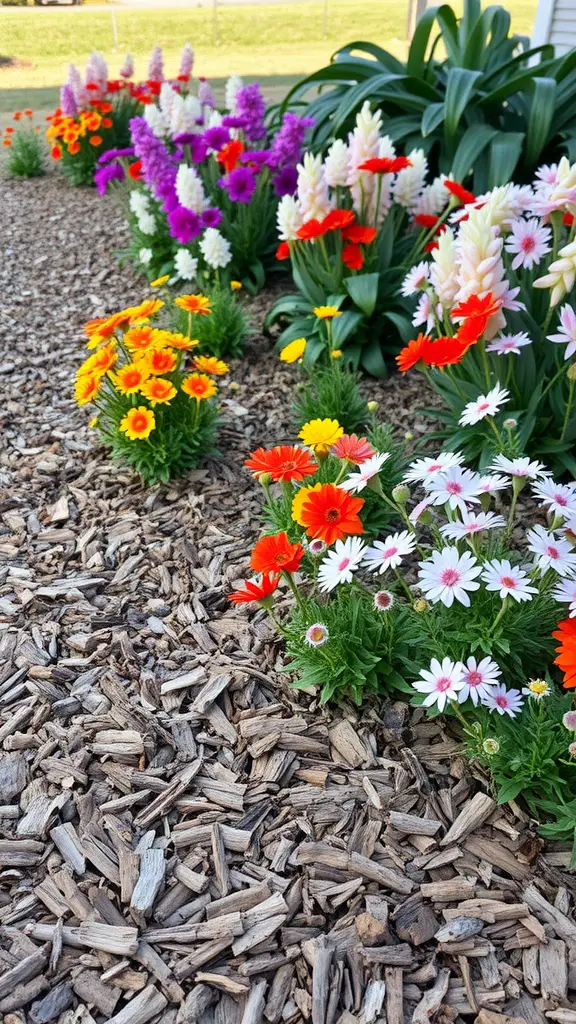
Mulched flower borders are a great way to enhance your garden while keeping maintenance low. The image shows a vibrant array of flowers nestled in a bed of mulch, creating a beautiful and inviting scene.
Using mulch not only adds visual appeal but also helps retain moisture in the soil. This is particularly beneficial during hot summer months. The variety of flowers, from bright oranges to soft whites, showcases how diverse your flower selection can be.
When planning your mulched flower borders, consider mixing annuals and perennials for continuous blooms throughout the seasons. This strategy keeps your garden lively and colorful.
Another advantage of using mulch is weed suppression. A thick layer of mulch can prevent weeds from popping up, saving you time and effort. Plus, it can improve soil quality as it breaks down over time.
Overall, mulched flower borders offer a simple yet effective way to beautify your landscape while minimizing upkeep. They can be tailored to fit any garden style, making them a versatile choice for any homeowner.
Drought-Resistant Plants
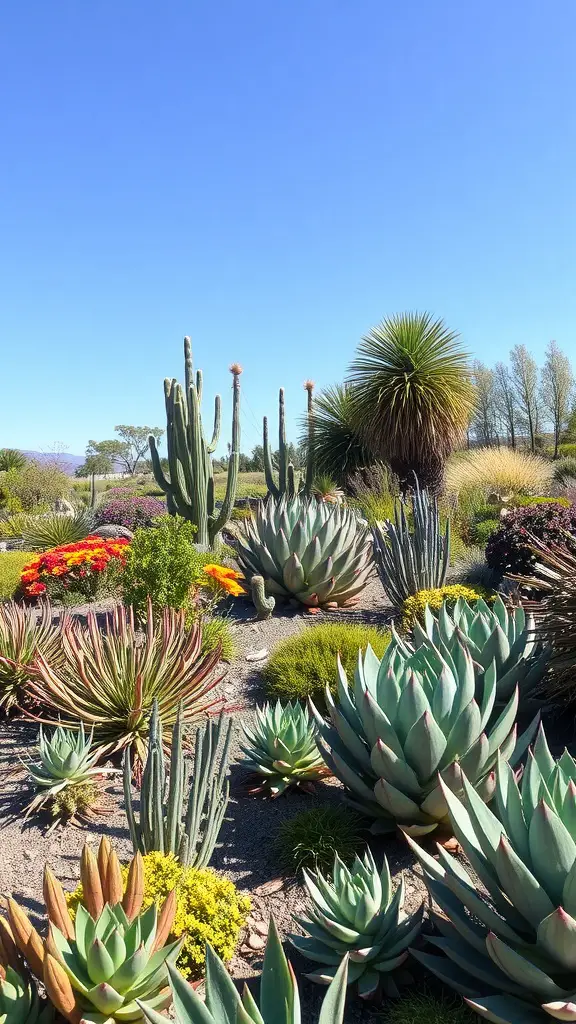
Drought-resistant plants are a fabulous choice for anyone looking to create a beautiful landscape without the hassle of constant watering. In the image, you can see a vibrant display of succulents and cacti, showcasing how diverse and colorful these plants can be.
These plants thrive in dry conditions and require minimal care, making them perfect for busy lifestyles. They often have unique shapes and colors, adding a fun touch to your garden. As you can see, the various textures and heights of the plants help to create visual interest without needing a lot of upkeep.
Incorporating drought-resistant plants not only saves water but can also reduce your gardening expenses. Many of these plants are native to arid regions, meaning they are well adapted to survive with little moisture. Therefore, they can flourish even in the heat of summer.
When planning your landscape, consider mixing different varieties of succulents with ornamental grasses and a few bold flowering plants. This combination can create a lively and inviting space where you can relax and enjoy the beauty of nature.
Perennial Flower Beds
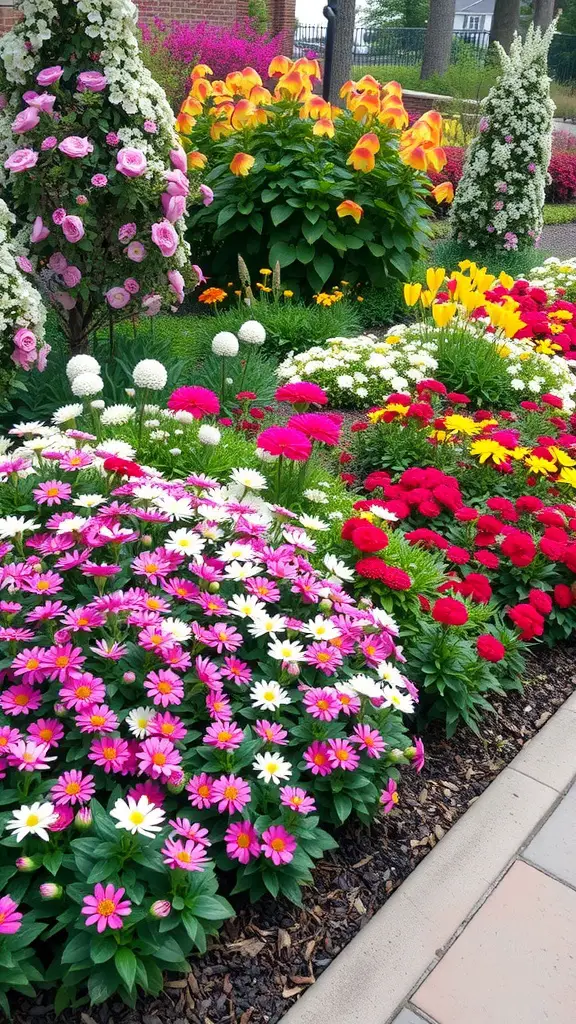
Perennial flower beds are a wonderful way to add beauty and color to your landscape without too much hassle. They bloom year after year, which means you get to enjoy their vibrant displays without the need for constant replanting.
In the image, you can see a mixture of colorful flowers. The pink and white daisies create a cheerful vibe, while the bold reds and yellows draw the eye. This variety not only looks appealing but also caters to different seasons, ensuring something is always in bloom.
Choose flowers like peonies, daylilies, and coneflowers for your garden. These are not only low maintenance but also attract pollinators, adding life to your garden. When planted together, they create a harmonious blend that can transform any space into a thriving floral retreat.
Another tip is to layer your plants based on height. Taller flowers can be placed in the back with shorter ones in front. This not only enhances visual interest but also ensures that all plants receive sufficient sunlight and moisture.
Low-Maintenance Ground Covers

Ground covers are a fantastic solution for those looking to reduce yard work while still enjoying a lush look. The image showcases vibrant, glossy green plants that create a thick carpet of foliage. These plants are easy to care for and add a pop of color to any landscape.
Choosing the right ground cover can transform dull areas into inviting spaces. The plants in the picture are likely low-maintenance varieties, meaning they require minimal attention once established. They can thrive in various conditions, making them suitable for different garden spots.
A great advantage of ground covers is their ability to suppress weeds. As they spread, they cover the soil and block out sunlight, preventing pesky weeds from taking root. This means less time spent weeding and more time enjoying your garden.
In addition to being practical, these plants also support local wildlife. They can attract beneficial insects, which help pollinate other flowers in your garden. This interplay of nature can create a healthy ecosystem right in your backyard!
When selecting ground covers, consider factors like sunlight, soil type, and water needs. By choosing plants that suit your garden’s conditions, you’ll create a thriving landscape that looks great with minimal effort.
Artificial Turf Installation

Artificial turf is a smart choice for low maintenance landscapes. The bright green surface in the image shows how synthetic grass can transform any outdoor space. It’s perfect for those who want a vibrant look without the hassle of traditional grass care.
In the photo, the turf is set against a backdrop of decorative stone and a variety of plants. This contrast adds depth and character, making the area feel inviting. The clean lines of the turf layout complement the modern aesthetic of the home.
Installing artificial turf requires some preparation. Begin by measuring your space and selecting the right type of turf for your needs. After leveling the ground, a weed barrier is usually laid down to prevent growth from below.
Once the base is ready, the turf can be rolled out and secured in place. Adding edging, like the stones in this image, helps define the area and keeps the turf in shape. With minimal upkeep, your yard can look lush all year round!
Xeriscaping Techniques
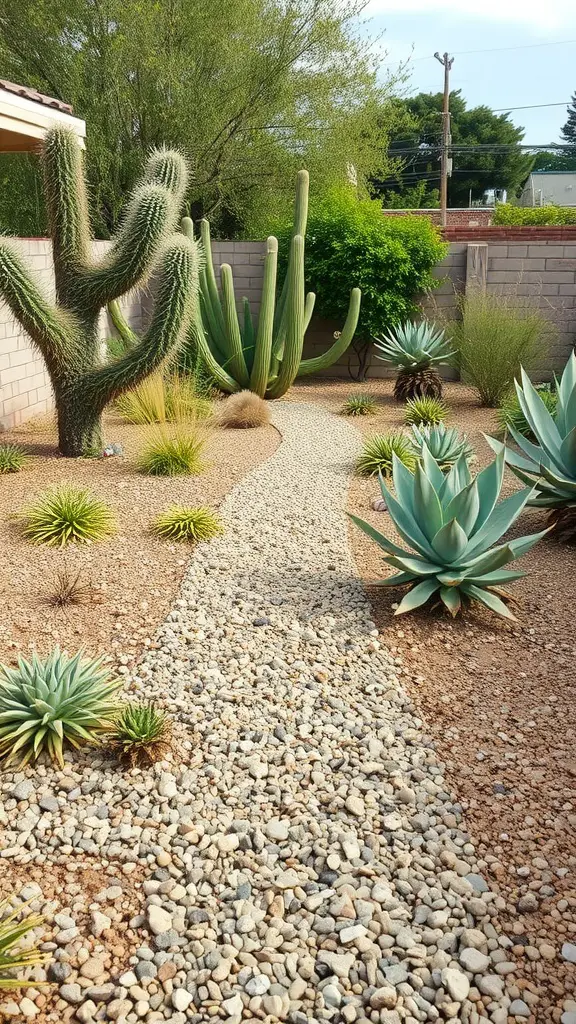
Xeriscaping is all about creating a beautiful landscape while conserving water. The image above showcases a well-designed xeriscape garden, featuring a variety of drought-resistant plants. Notice how the pathway winds through the plants, making it easy to navigate while adding a touch of charm.
This particular garden uses different types of succulents and cacti, which thrive in dry conditions. The use of gravel instead of grass not only reduces water usage but also gives the garden a modern look. Plus, it requires minimal maintenance!
When planning your xeriscape, consider grouping plants with similar watering needs together. This approach minimizes water waste and helps the plants flourish. Additionally, incorporating hardscaping elements like the rock pathway in the image can enhance the aesthetic while also serving practical purposes.
Overall, xeriscaping offers a low-maintenance solution for those looking to create an attractive garden without the hassle of extensive watering. It’s a friendly approach for both the environment and your schedule!
Succulent Arrangements
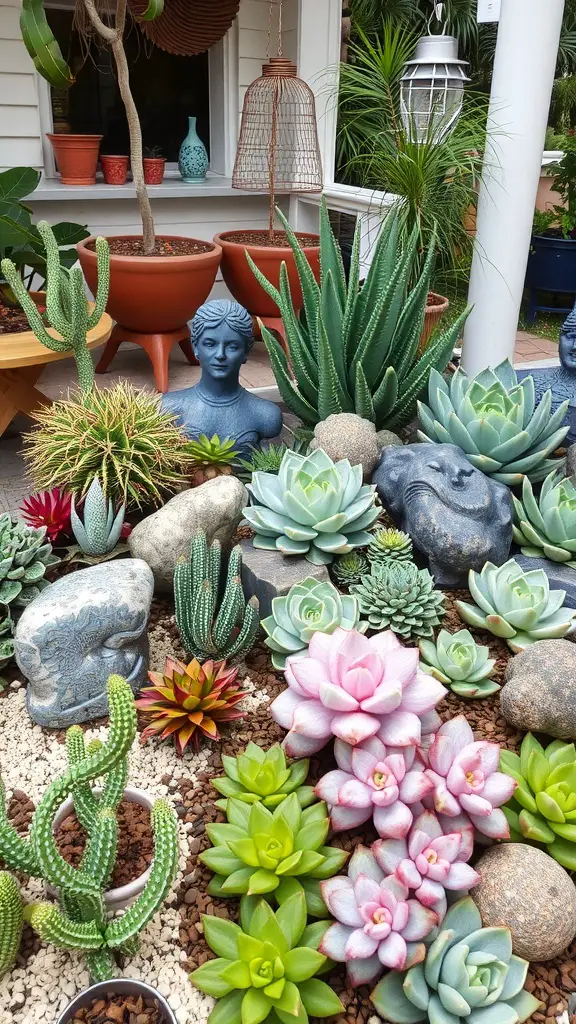
Succulents have become a popular choice for those looking for an easy-care addition to their landscape. The image showcases a vibrant arrangement of various succulents, showcasing their unique shapes and colors.
This specific setup includes a mix of different types of succulents, from the tall, spiky varieties to the soft, round ones. The contrast between the greens, pinks, and reds adds visual interest and makes the arrangement stand out.
Incorporating decorative stones and sculptures can enhance the look as well. In this case, the placement of rocks and artistic figures brings an additional layer of charm to the overall design.
When creating your own succulent arrangements, consider varying the heights and colors. This creates depth and draws the eye in. Additionally, succulents thrive in well-draining soil, so make sure to choose the right mix for your plants.
Ornamental Grasses

Ornamental grasses are a fantastic choice for low maintenance landscapes. They add texture and movement without needing a lot of attention. In the image, you can see tall grasses with soft, feathery plumes swaying in the light. This kind of beauty requires little care, making it ideal for busy homeowners.
One of the best things about ornamental grasses is their versatility. They come in various shapes, sizes, and colors, offering plenty of options for your garden. Whether you choose tall varieties like pampas grass or shorter ones like blue fescue, they can fit into many design styles.
Another perk is that these grasses thrive in a range of conditions. Most are drought-tolerant and can handle poor soil, which means you can plant them and enjoy their beauty without worrying about frequent watering or fertilizing. This frees up your time for other gardening projects or simply relaxing in your outdoor space.
In addition to their low maintenance needs, ornamental grasses attract wildlife. They provide shelter for birds and can be a food source for various insects. This not only makes your garden lively but also supports local ecosystems.
Container Gardening

Container gardening is a fantastic way to add greenery to any space without the commitment of traditional landscaping. It allows you to create a vibrant oasis right on your patio or porch. The image shows an array of colorful pots filled with a variety of plants, showcasing just how easy it can be to achieve a lively outdoor look.
Using containers means that you can mix and match plants based on your preference and the climate. From succulents to flowering plants, the options are endless! You can even change them seasonally, keeping your garden fresh and inviting throughout the year.
One of the best things about container gardening is its low maintenance nature. Many plants thrive in pots since they have better drainage. Plus, if you pick drought-resistant species, you won’t need to water them often. Just ensure they get enough sunlight, and you’re all set!
Don’t forget to play with different pot sizes and colors to create a visually appealing arrangement. Grouping pots of varying heights can also add dimension to your space. Whether you’re a seasoned gardener or just getting started, container gardening can be a fun and rewarding hobby.
Shade-Tolerant Shrubs
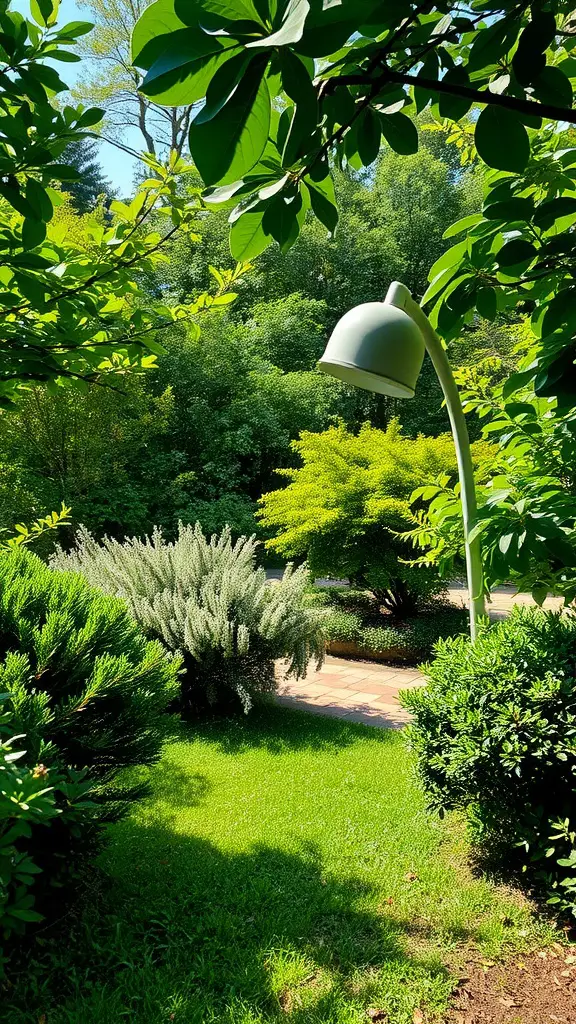
When it comes to landscaping, shade-tolerant shrubs can make a big difference in areas with limited sunlight. The image showcases a vibrant garden filled with lush greenery, highlighting the beauty of these hardy plants. The carefully arranged shrubs create a soothing atmosphere, perfect for relaxing in a shady nook.
In the picture, various shrubs are thriving under the canopy of leafy trees. Notice how the different textures and colors complement each other. This variety not only adds visual interest but also provides a habitat for local wildlife. Using shade-tolerant shrubs can help you maintain a lush landscape without requiring constant upkeep.
Some popular shade-tolerant options include Boxwood, Rhododendron, and Azalea. These plants are known for their resilience and ability to flourish in low-light conditions. Incorporating them into your garden can transform even the shadiest spots into inviting spaces.
Additionally, consider combining these shrubs with ground cover plants to enhance the overall look. This combination reduces weeds and keeps the area tidy, making it a practical choice for low-maintenance landscaping.
Hardscape Features

Hardscaping is all about using non-plant materials to create beautiful outdoor spaces. This image showcases a lovely pathway made of stone pavers, leading through a carefully designed yard. It’s a perfect example of how hardscape features can blend functionality with style.
The stones in the pathway are laid out in a way that adds visual interest while being practical. This makes it easy to walk through the garden without worrying about muddy shoes. Plus, the laid-back seating area with comfortable chairs invites you to sit back and enjoy the surroundings.
Notice how the natural elements, like the small plants and decorative stones, work in harmony with the hardscaping. This balance makes the landscape feel welcoming and low maintenance. With less grass to mow and fewer plants to water, you can spend more time relaxing in your outdoor space.
Using features like wooden benches and planters not only enhances the aesthetic but also provides additional seating and decoration without much upkeep. Incorporating hardscape elements is a smart way to create a beautiful yard that doesn’t demand constant attention.
Cacti Landscapes
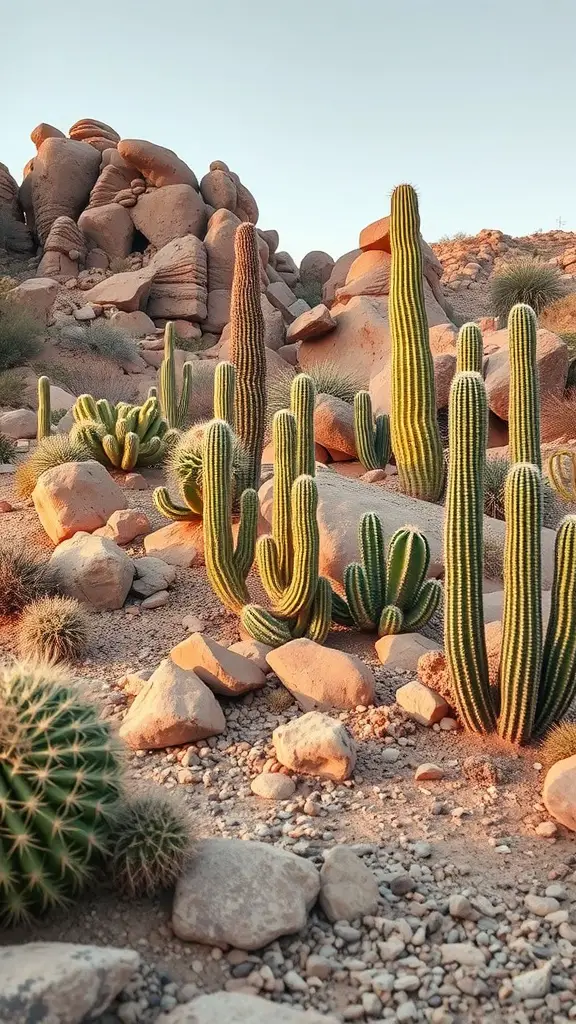
Cacti landscapes are a stylish choice for anyone looking to maintain a beautiful yard without a lot of effort. This image showcases a vibrant arrangement of various cacti, set against a backdrop of stunning rock formations. The unique shapes and sizes of the cacti create a lively scene that’s both eye-catching and low maintenance.
One of the best things about cacti is their resilience. These plants thrive in dry, hot conditions and require minimal watering. This makes them perfect for those who may not have the time to tend to a traditional garden. Pairing them with rocks and gravel can enhance the desert vibe while ensuring good drainage.
For added interest, consider mixing different types of cacti. Taller varieties can provide height, while smaller ones can fill in the spaces around them. The contrast of colors and textures will keep your landscape looking fresh and inviting.
Another bonus? Cacti attract various pollinators, adding life to your garden. So, if you want a landscape that looks good and supports local wildlife, a cacti garden is a lovely option.
Vertical Gardens
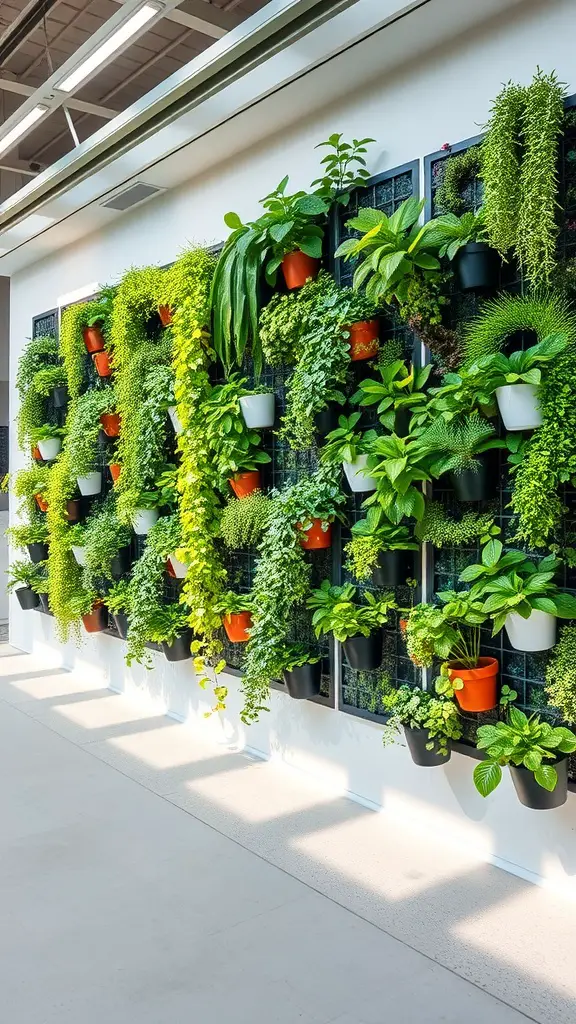
Vertical gardens are a trendy and practical way to bring greenery into your space, especially if you’re short on ground area. This image showcases a beautifully arranged wall of plants in various pots, creating a lush atmosphere. The combination of vibrant greens and earthy tones offers a refreshing sight that can easily uplift any indoor or outdoor area.
One of the best things about vertical gardens is their low maintenance nature. Choosing hardy plants that require minimal care can save you time and effort. Plants like ferns and succulents thrive in vertical settings, making them ideal for busy lifestyles. You can enjoy the benefits of greenery without the heavy lifting.
Installing a vertical garden can also enhance your home’s aesthetic. It’s a creative way to turn a blank wall into a living masterpiece. The varied heights and colors of the plants can add depth and interest to your decor. Plus, you can customize the layout to fit your personal style and space constraints.
If you’re considering starting a vertical garden, think about how much sunlight the area receives. Some plants prefer bright light, while others thrive in shade. This will help you choose the right plants and ensure your vertical garden flourishes.
Rain Gardens

Rain gardens are a fantastic way to manage stormwater while adding beauty to your landscape. These gardens are designed to collect rainwater runoff from roofs, driveways, and sidewalks. They allow water to soak into the ground rather than running off into storm drains. The image above showcases a lovely rain garden filled with lush green plants and colorful flowers.
In this picture, you can see various plant types thriving together. The tall white flowers bring a touch of elegance, while the vibrant yellow blooms in the foreground add a pop of color. The mixture of textures from the plants creates a visually appealing layout. This approach not only looks great but also supports local wildlife.
When planning a rain garden, consider using native plants. They are well-adapted to your local climate and require less maintenance. Plus, they attract pollinators like bees and butterflies. The key is to select plants that can handle both wet and dry conditions since the garden will experience standing water after heavy rains.
Incorporating rocks and mulch can enhance drainage and reduce erosion. The stones in the image serve both functional and aesthetic purposes. They help filter the water while adding a natural look to the space. Overall, a rain garden is a smart choice for anyone looking to create a low-maintenance landscape that benefits the environment.
Fruit Trees for Small Spaces

When it comes to small spaces, adding fruit trees is a smart choice. They not only provide delicious produce but also enhance the beauty of your outdoor area. The image showcases two healthy fruit trees, heavily laden with bright, ripe fruits. Their vibrant colors contrast beautifully with the lush green leaves, creating a cheerful atmosphere.
These compact trees are perfect for gardens with limited space. They can be planted in pots or in the ground, depending on your layout. The choice of fruit trees can vary, from citrus to stone fruits, and each brings its unique charm. Plus, they tend to require less maintenance than larger trees, making them ideal for busy lifestyles.
Maintaining small fruit trees is straightforward. Regular watering and occasional pruning can keep them in shape. Harvesting the fruits adds a fun, rewarding task to your gardening routine. Imagine stepping outside to pick fresh fruit right from your garden!
Pollinator-Friendly Gardens
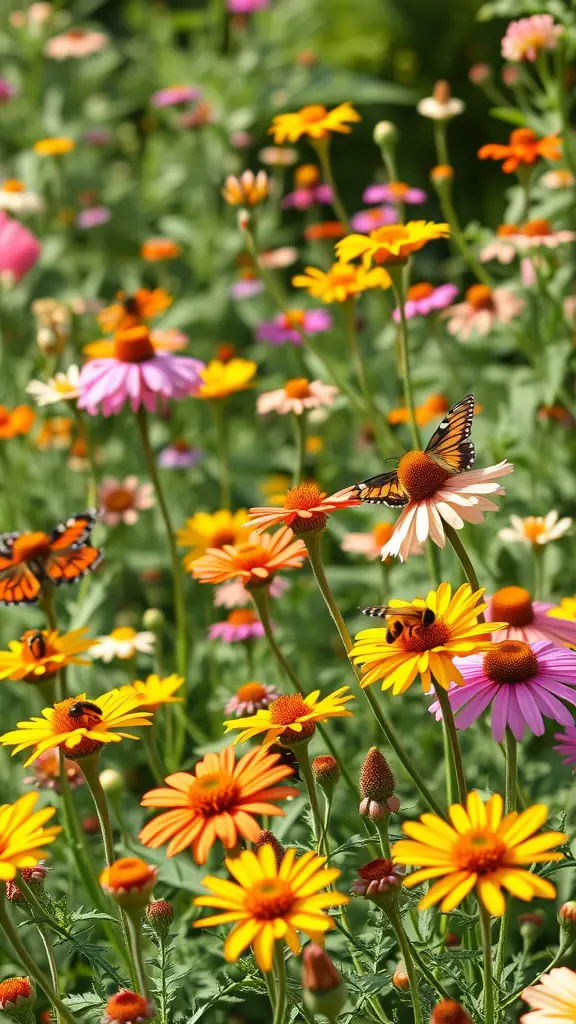
Creating a pollinator-friendly garden is a delightful way to support nature while adding beauty to your outdoor space. The image showcases a vibrant mix of colorful flowers, with butterflies and bees happily buzzing from bloom to bloom. This lively scene captures the essence of a garden that invites these important creatures.
When planning your garden, consider native plants that thrive in your region. Plants like coneflowers, daisies, and asters not only attract pollinators but also require less maintenance. They are well-adapted to local conditions, making them easier to care for.
Incorporating a variety of flower types can help ensure that there’s something blooming throughout the seasons. This not only provides a constant food source for pollinators but also keeps your garden looking fresh and lively year-round. By establishing a diverse planting scheme, you’ll create a habitat that encourages butterflies and bees to visit frequently.
Additionally, a pollinator garden can be low maintenance. Once established, many native species require minimal watering and weeding. Creating a mulch layer can help retain moisture and suppress weeds, making your gardening experience more enjoyable.
Don’t forget to include elements like rocks and small logs. These features can provide shelter for pollinators during bad weather or at night. A simple water source, like a shallow dish filled with pebbles and water, can also make your garden more inviting.
Edible Landscaping
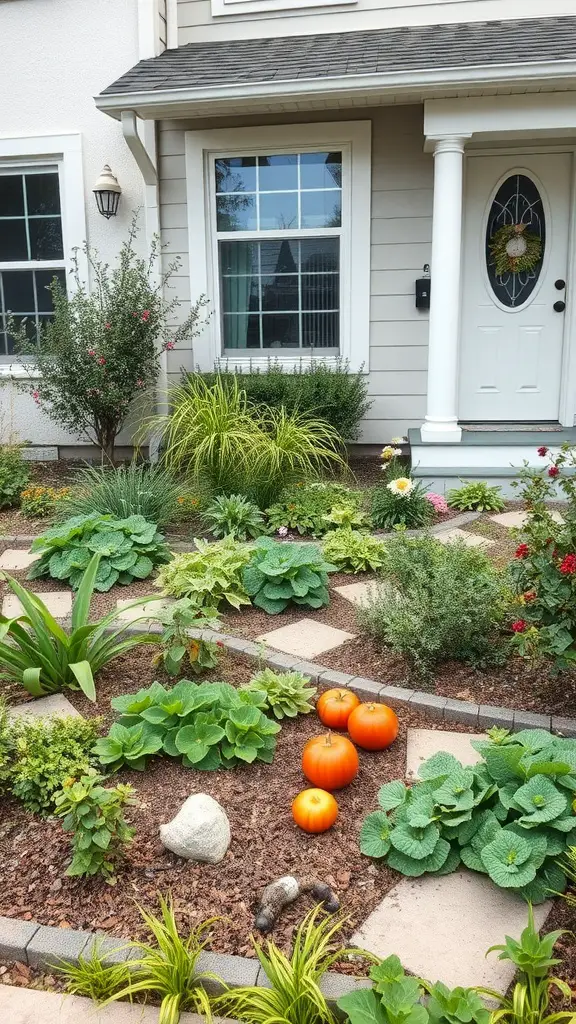
Edible landscaping is a wonderful way to incorporate food-producing plants into your garden design. The image showcases a charming front yard filled with a variety of edible plants, including vibrant pumpkins and lush leafy greens. This approach not only adds beauty to your space but also provides fresh produce right at your doorstep.
The arrangement of the plants creates a visually appealing pathway, blending aesthetics with functionality. The pumpkins, with their bright orange color, stand out beautifully against the green foliage. This design encourages a casual stroll through the yard, inviting you to pick a vegetable or two for dinner.
Layering different types of plants and using natural stones can simplify maintenance while maximizing your harvest. Consider adding herbs like basil and mint among your decorative plants; they not only provide flavor but also attract beneficial insects. By integrating edible landscaping, your garden can be both a feast for the eyes and the table.
Minimalist Zen Gardens

Minimalist Zen gardens are all about simplicity and tranquility. The image showcases a serene space with smooth, white sand and carefully placed stones. This design encourages mindfulness and reflection.
The arrangement of the rocks creates a natural flow. The gentle curves in the sand mimic the ripples of water, adding a calming effect. A small tree stands nearby, bringing a touch of greenery into this otherwise neutral palette.
Creating your own Zen garden can be a fun project. Choose a small area in your yard or even a container for indoors. Use fine gravel or sand as a base, and select a few stones that speak to you. The key is to keep it simple and let nature take center stage.
These gardens require minimal maintenance, making them an excellent choice for busy lifestyles. Raking the sand occasionally and ensuring the plants stay healthy is usually all it takes. A minimalist Zen garden can transform any space into a peaceful retreat.
Permeable Paving Solutions
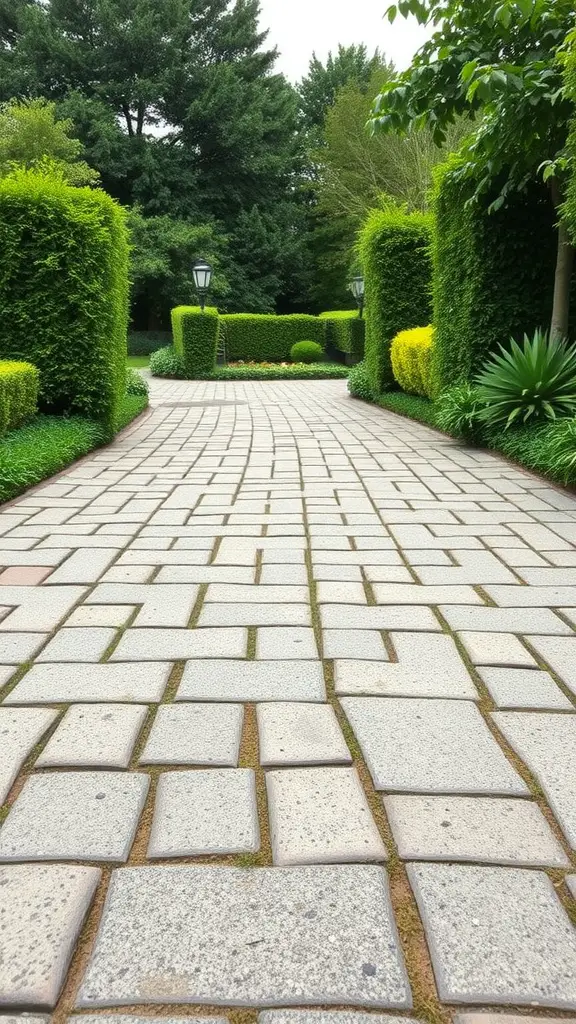
When it comes to low maintenance landscapes, permeable paving stands out as a smart choice. The image showcases a beautifully laid pathway made of pavers that allow water to seep through. This design not only looks inviting but also helps manage rainwater effectively.
Permeable paving is a practical solution for driveways and walkways. It reduces water runoff, which can prevent flooding and erosion in your yard. Plus, the gaps between the stones can be filled with grass or small plants, adding a touch of greenery.
Another benefit is that these surfaces require less upkeep compared to traditional concrete or asphalt. You won’t have to worry about cracks or extensive repairs. Regular maintenance is simple—just keep the surface clear of debris and the grass in the joints trimmed.
Incorporating permeable paving into your landscape not only enhances its appearance but also contributes to a healthier environment. With a variety of styles and colors available, it’s easy to find a design that fits your aesthetic.
Seasonal Color with Foliage
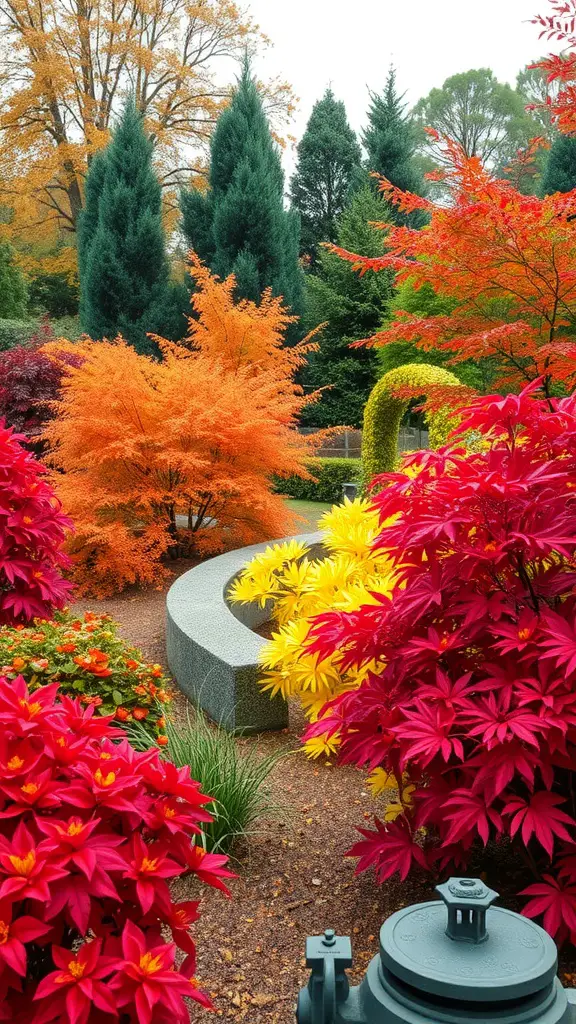
Incorporating seasonal color in your landscape can be a delightful way to keep your garden lively and engaging throughout the year. The image showcases a vibrant arrangement of foliage, featuring fiery reds, sunny yellows, and warm oranges. This explosion of color creates a stunning visual impact that invites you to spend time outdoors.
Using a mix of trees and shrubs allows you to enjoy a palette that changes with each season. The tall conifers in the background provide a lush, green backdrop, while the colorful deciduous plants bring life and warmth to the scene. This kind of foliage is low maintenance, making it an easy choice for any garden.
Consider selecting plants that offer year-round interest. For instance, certain maples turn brilliant shades in autumn, while evergreens maintain their color through winter. By mixing these elements, you can create a visually appealing landscape that requires minimal upkeep. A curved pathway, like the one shown, can guide visitors through your colorful retreat and encourage exploration.
Don’t forget to add some ground cover plants and perennials to fill in the gaps. They can provide additional texture and color throughout the seasons, making your landscape even more inviting. With a little planning, you can achieve a beautiful garden that celebrates seasonal changes without demanding too much of your time.
Evergreen Borders
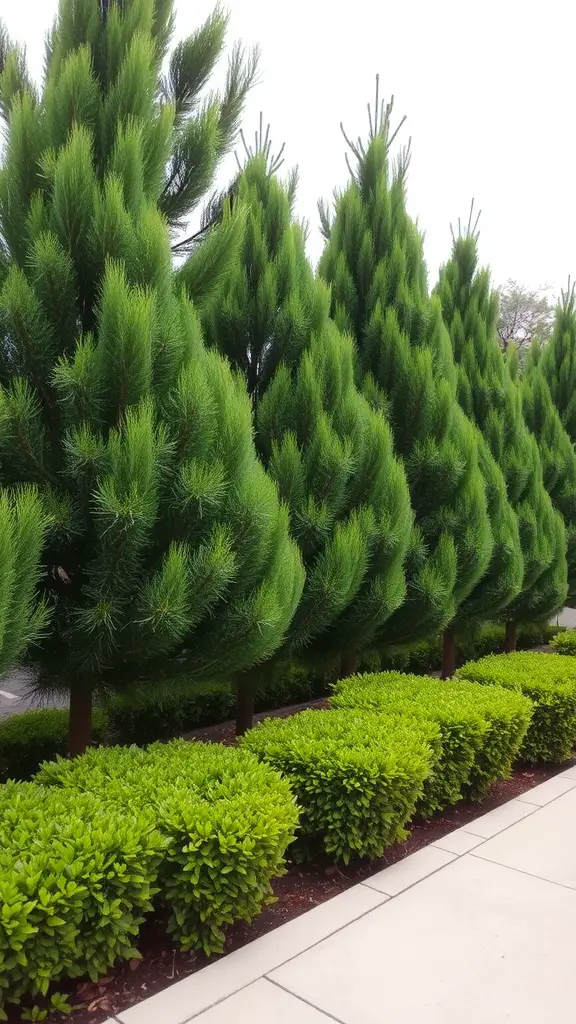
Evergreen borders are a fantastic way to add structure and year-round greenery to your landscape. In the image, we see a neatly arranged row of tall evergreen trees paired with low shrubs. This combination creates a vibrant and lush appearance that enhances any space.
The tall evergreen trees stand proudly, providing privacy and a natural backdrop. They offer a sense of permanence, remaining green through every season. The shrubs in front add a soft touch, creating a visually appealing contrast with their rounded shapes and bright color.
Choosing the right plants is key to a low-maintenance landscape. Evergreens require less trimming and watering compared to flowering plants. This allows you to spend more time enjoying your garden rather than maintaining it.
For those looking to create similar borders, consider mixing species for variety while maintaining a cohesive look. This approach will keep your landscape interesting without demanding too much attention.
Wildflower Meadows
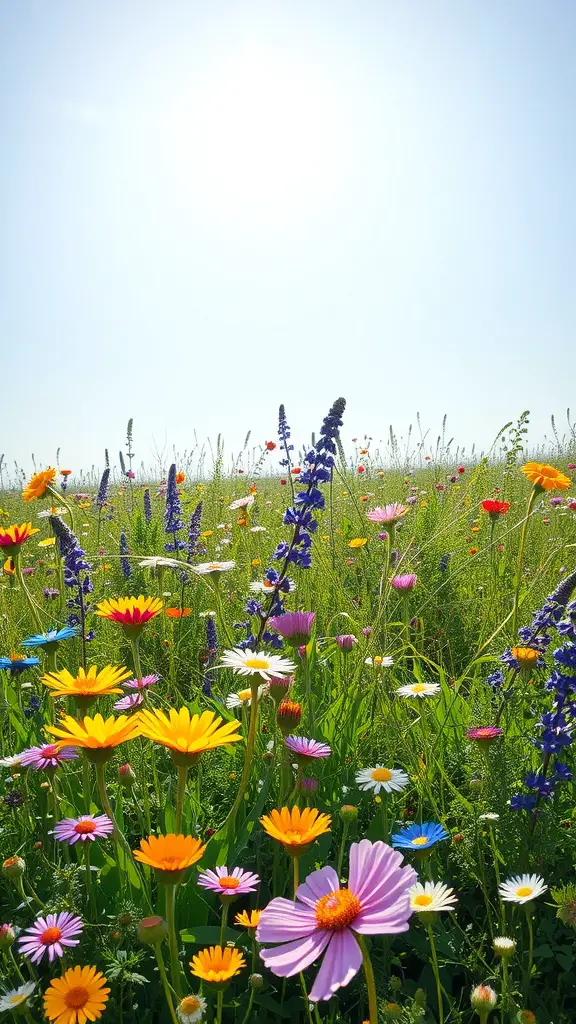
Wildflower meadows are a delightful way to add color and charm to your landscape without demanding too much from you. Imagine stepping outside to a vibrant patch of blooms that dance gently in the breeze. These meadows can attract bees, butterflies, and other pollinators, creating a lively ecosystem right in your yard.
The image above beautifully showcases a variety of wildflowers, featuring hues of yellow, pink, and purple against a bright blue sky. This simple yet stunning display exemplifies how a wildflower meadow can transform any space. The diverse plant life not only looks cheerful but also requires less maintenance than traditional gardens.
One of the best parts about wildflower meadows is their low upkeep. Once established, they often thrive on natural rainfall and require minimal mowing. This makes them perfect for busy homeowners or anyone looking to simplify their gardening routine. When you plant a mix of native wildflowers, you’ll enjoy a blooming landscape that naturally adapts to your local environment.
If you’re considering creating your own wildflower meadow, start by preparing the soil and selecting a mix of local wildflower seeds. Scatter them in the spring or fall, and let nature work its magic. Over time, you’ll have a colorful and inviting space that changes with the seasons, providing beauty and joy with every visit.
Drought-Resistant Planting Schemes

Drought-resistant planting schemes are not just practical; they can also be visually appealing. The image showcases a vibrant landscape filled with diverse, drought-tolerant plants. Bright blooms of bougainvillea and yellow marigolds contrast beautifully with the green succulents and agave. This combination creates a lively yet low-maintenance garden.
The use of gravel and stone in the landscape provides excellent drainage and helps retain moisture in the soil. This design minimizes the need for frequent watering, making it ideal for arid climates. Incorporating native plants in your garden can further enhance drought resistance, as they are adapted to the local environment.
When planning your garden, consider grouping plants with similar water needs together. This will make it easier to manage their care and maximize their growth potential. With the right selection, your garden can be both sustainable and colorful, just like the one in the image!
Grazing Lawn Alternatives

If you’re tired of traditional lawns that require constant mowing and watering, consider grazing lawn alternatives. The image showcases a lush patch of clover and grass, highlighting the beauty and practicality of these low-maintenance options.
Clover is a popular choice in grazing lawns. It’s hardy, drought-resistant, and doesn’t need much upkeep. Plus, it attracts beneficial pollinators, making your outdoor space more vibrant. The mix of clover and grass in the photo offers a soft, green carpet that feels great underfoot.
Another benefit of grazing lawns is their ability to fix nitrogen in the soil. This means healthier soil and less need for chemical fertilizers. While traditional grass lawns can deplete nutrients, clover enriches them naturally. So, you can enjoy a lush landscape without the heavy lifting!
Incorporating these alternatives into your yard is simple. Start by seeding a mix of clover and fine fescue for a low-growing, resilient lawn. Allow it to grow freely and enjoy the effortless beauty of your new outdoor space.
Decorative Stone Features

Using decorative stone features in landscape design is a simple way to add visual interest while keeping maintenance low. The image showcases a charming pathway created with grey stones, leading through a bed of carefully arranged pebbles and larger rocks.
These stones not only serve as a practical walkway but also create a natural flow in your garden space. Surrounding greenery, such as neatly trimmed trees and grasses, complements the stonework perfectly, adding a touch of elegance without requiring much upkeep.
Incorporating stones can also help manage water drainage, making them a smart choice for various climates. You can mix and match different sizes and colors of stones to personalize your landscape according to your style.
Another bonus is that these features blend well with other elements like mulch or ornamental plants. A small bush nestled among the rocks in the image adds a pop of color, enhancing the overall aesthetic without demanding constant care.

